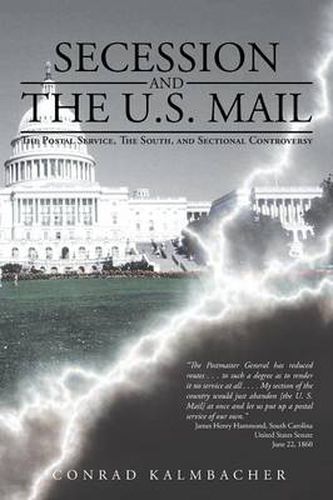Readings Newsletter
Become a Readings Member to make your shopping experience even easier.
Sign in or sign up for free!
You’re not far away from qualifying for FREE standard shipping within Australia
You’ve qualified for FREE standard shipping within Australia
The cart is loading…






This title is printed to order. This book may have been self-published. If so, we cannot guarantee the quality of the content. In the main most books will have gone through the editing process however some may not. We therefore suggest that you be aware of this before ordering this book. If in doubt check either the author or publisher’s details as we are unable to accept any returns unless they are faulty. Please contact us if you have any questions.
In Secession and the U. S. Mail: The Postal Service, The South, and Sectional Controversy, Conrad Kalmbacher tells the little known story of over fifty years of dissension between the Post Office Department and the South, culminating in the department’s role in the events leading to secession and the Guns of April 1861. Severe reductions and retrenchment in mail service throughout the South and on Mississippi River steamboats during the administration of Postmaster General Joseph Holt, 1859-1860, angered southern senators and congressmen against the federal government. Deploring the postmaster general’s policy, southern leaders called Holt “our bitter foe” who, “by a mere stroke of his pen” had curtailed mail service in the South “to such a degree as to render it no service at all.” Because of this bitter anger, one Pulitzer Prize-winning historian characterized Holt’s policy as “one of the less tangible factors leading to secession.” Drawing on House and Senate documents, postmasters general reports, and Congressional debates, as well as personal letters, diaries, memoirs, and newspapers of the time, the author makes extensive use of primary sources. The book details how antagonisms between the Postal Service and the South had their beginnings early on in American history: “Continual debates questioned whether the South received its fair share of federal dollars for post offices and post routes. Southerners defended the maintenance of unprofitable mail routes in remote areas. Negro postriders caused resentment among Southerners. And years of controversy inflamed the South over the distribution of abolitionist literature through the mails.” Today, when the role of government is a central issue in American politics, it is revealing to consider the ominous signposts of 1859-1860, as the Post Office Department - at that time the principal political agency of the federal government - became embroiled in overheated debate, partisan bickering, and failed compromise.
$9.00 standard shipping within Australia
FREE standard shipping within Australia for orders over $100.00
Express & International shipping calculated at checkout
This title is printed to order. This book may have been self-published. If so, we cannot guarantee the quality of the content. In the main most books will have gone through the editing process however some may not. We therefore suggest that you be aware of this before ordering this book. If in doubt check either the author or publisher’s details as we are unable to accept any returns unless they are faulty. Please contact us if you have any questions.
In Secession and the U. S. Mail: The Postal Service, The South, and Sectional Controversy, Conrad Kalmbacher tells the little known story of over fifty years of dissension between the Post Office Department and the South, culminating in the department’s role in the events leading to secession and the Guns of April 1861. Severe reductions and retrenchment in mail service throughout the South and on Mississippi River steamboats during the administration of Postmaster General Joseph Holt, 1859-1860, angered southern senators and congressmen against the federal government. Deploring the postmaster general’s policy, southern leaders called Holt “our bitter foe” who, “by a mere stroke of his pen” had curtailed mail service in the South “to such a degree as to render it no service at all.” Because of this bitter anger, one Pulitzer Prize-winning historian characterized Holt’s policy as “one of the less tangible factors leading to secession.” Drawing on House and Senate documents, postmasters general reports, and Congressional debates, as well as personal letters, diaries, memoirs, and newspapers of the time, the author makes extensive use of primary sources. The book details how antagonisms between the Postal Service and the South had their beginnings early on in American history: “Continual debates questioned whether the South received its fair share of federal dollars for post offices and post routes. Southerners defended the maintenance of unprofitable mail routes in remote areas. Negro postriders caused resentment among Southerners. And years of controversy inflamed the South over the distribution of abolitionist literature through the mails.” Today, when the role of government is a central issue in American politics, it is revealing to consider the ominous signposts of 1859-1860, as the Post Office Department - at that time the principal political agency of the federal government - became embroiled in overheated debate, partisan bickering, and failed compromise.